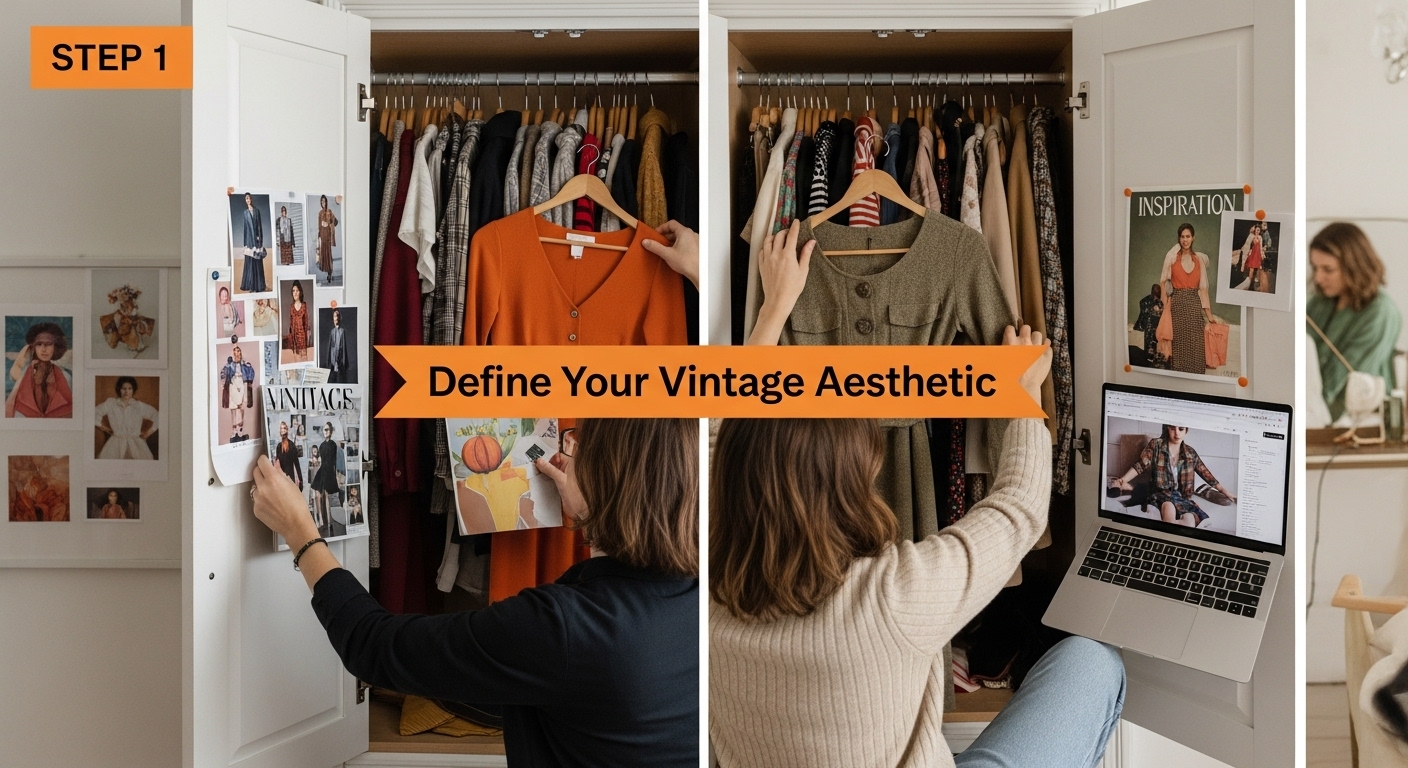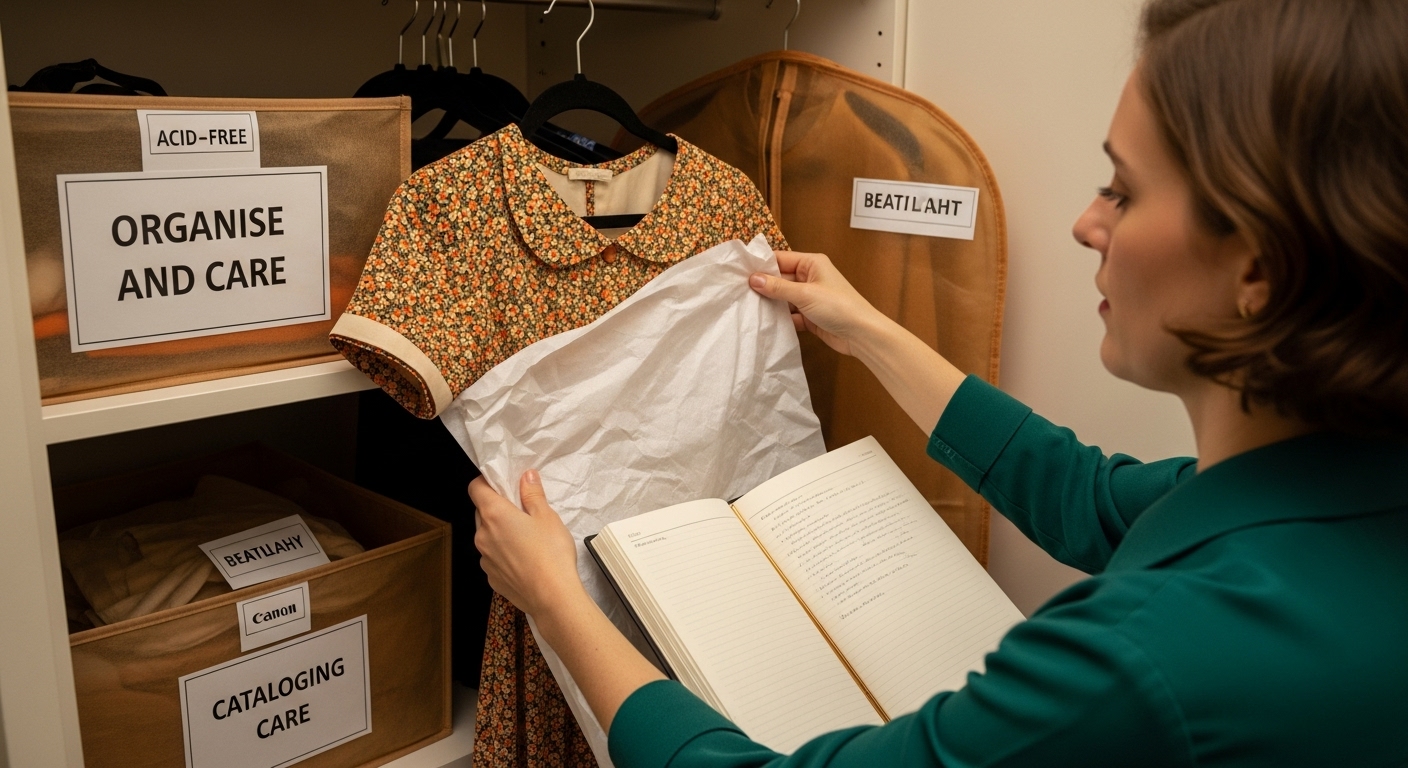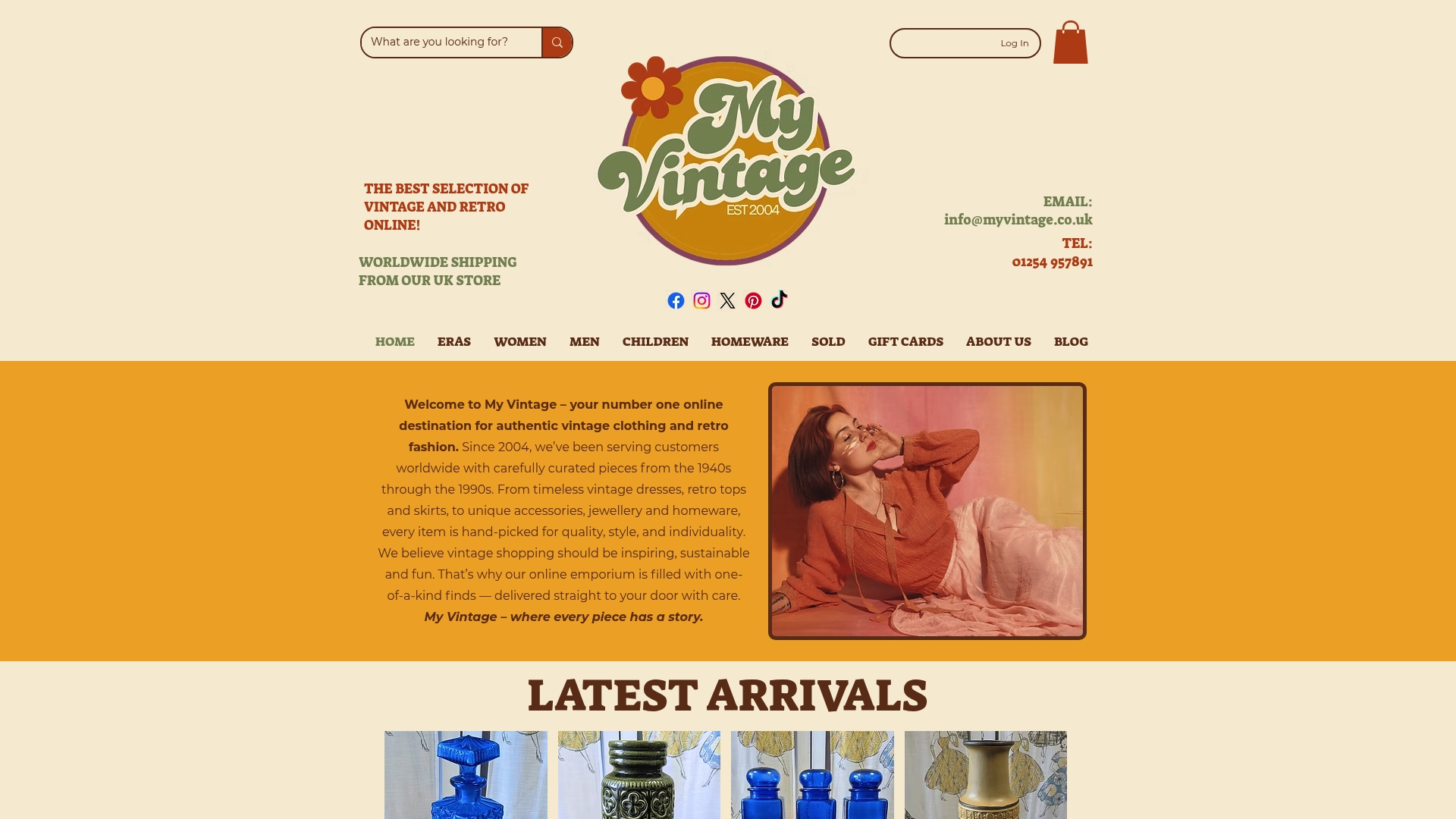Master Curating Vintage Wardrobes: A Step-by-Step Guide
- Emma

- Sep 28
- 10 min read

Building a vintage wardrobe is about more than just finding beautiful old clothes. A single authentic 1950s wool coat can outlast ten items from high street shops in both quality and charm. Most people rush to collect, thinking more is better. The real surprise is that curating your vintage style starts with slowing down, defining your own aesthetic, and letting patience lead the way.
Table of Contents
Quick Summary
Key Point | Explanation |
1. Define your vintage aesthetic first | Reflect on personal styles and historical influences to shape your unique fashion identity. |
2. Research vintage styles and eras | Use historical resources to understand diverse fashion narratives and enhance your wardrobe selection. |
3. Establish a clear budget | Allocate a specific percentage of discretionary income for vintage purchases to ensure financial balance. |
4. Source authentic vintage pieces | Focus on identifying true vintage items through reputable sellers and assess construction details for authenticity. |
5. Organise and care for your wardrobe | Employ proper storage and maintenance techniques to preserve vintage garments as valuable pieces of history. |
Step 1: Define Your Vintage Aesthetic
Curating a vintage wardrobe begins with understanding your personal aesthetic a critical first step in transforming your style narrative. Your vintage journey is about discovering a unique visual language that speaks to your individuality and connects you with fashion history. Think of this process as crafting a personal style blueprint that transcends mere clothing selection and becomes a genuine expression of your identity.
The foundation of defining your vintage aesthetic involves deep self reflection and visual research. Start by exploring different historical fashion eras and identifying which periods resonate most powerfully with your personality. Are you drawn to the structured elegance of 1940s silhouettes, the rebellious spirit of 1950s rockabilly styles, or perhaps the free flowing bohemian designs of 1970s fashion? Each era carries its own distinctive visual signature and emotional resonance.
Photographic archives, vintage fashion magazines, and museum collections become your primary research tools. Platforms like Pinterest and Instagram offer incredible visual inspiration, allowing you to create mood boards that capture your emerging aesthetic. Explore our guide on styling vintage outfits to help refine your visual direction. Pay attention to recurring themes colour palettes, fabric textures, and clothing cuts that consistently attract your eye.
Consider practical aspects alongside aesthetic preferences. Your vintage aesthetic must harmonise with your body type, lifestyle, and personal comfort. A meticulously curated wardrobe should not only look stunning but also feel authentically you. Experiment with different vintage styles through carefully selected pieces that can be mixed and matched, allowing flexibility and personal interpretation within your chosen aesthetic framework.
Successful aesthetic definition emerges from patient exploration and genuine self discovery. Trust your instincts, remain open to unexpected inspirations, and remember that your vintage style is a continuously evolving narrative waiting to be written.
Step 2: Research Vintage Styles and Eras
Researching vintage styles and eras transforms your wardrobe curation from mere clothing selection to a thoughtful historical exploration. This critical step bridges your personal aesthetic vision with authentic fashion knowledge, enabling you to understand the nuanced characteristics of different periods and their unique sartorial languages.
Begin your research by immersing yourself in comprehensive visual and historical resources. Vintage fashion documentation becomes your primary investigative tool. Museums like the Victoria and Albert Museum offer incredible online collections that showcase intricate design details across decades. Digital archives, vintage fashion magazines, classic film collections, and photography exhibitions provide rich visual narratives about clothing evolution. Dive into our comprehensive vintage fashion tour to gain deeper insights into distinctive era characteristics.
Understanding each decade requires more than surface level observation. The 1940s embodied utility and structured silhouettes influenced by wartime practicality. The 1950s celebrated feminine curves with cinched waists and full skirts. The 1960s introduced radical geometric designs and bold colour palettes, while the 1970s embraced free flowing bohemian aesthetics. Each period carries distinct textile choices, manufacturing techniques, and sociocultural influences that shaped fashion statements.
Below is a table summarising the distinguishing characteristics of vintage fashion by era, as described in the guide, to help refine research and selection during wardrobe curation.
Era | Key Characteristics | Typical Fabrics | Iconic Styles/Details |
1940s | Utility, structured silhouettes | Wool, gabardine, rayon | Practical tailoring, military notes |
1950s | Feminine curves, cinched waists | Cotton, taffeta, wool | Full skirts, defined waists |
1960s | Geometric designs, bold colours | Jersey, synthetics | Mod lines, mini skirts |
1970s | Bohemian, free-flowing | Suede, denim, chiffon | Maxi dresses, flares, ethnic prints |
Documenting your research becomes crucial. Create comprehensive mood boards or digital archives that capture representative pieces, colour palettes, fabric textures, and characteristic design elements from your chosen eras. Sketch rough style interpretations, collect fabric swatches, and annotate your findings. This methodical approach transforms research from passive observation into active creative exploration.
Remember that authentic vintage research requires patience and curiosity. Your goal is not just collecting information but developing a nuanced understanding that will guide your wardrobe curation. Engage with vintage fashion communities, attend exhibition openings, and connect with collectors who can share profound insights into historical fashion narratives.
Step 3: Set a Budget for Your Wardrobe
Establishing a strategic budget for your vintage wardrobe represents a critical intersection between passion and financial prudence. Vintage collecting is an art form that requires thoughtful financial planning, transforming your fashion journey from impulsive purchasing to intentional curation. Your budget becomes a roadmap that guides investment decisions while protecting your financial wellbeing.
Begin by conducting an honest assessment of your current financial landscape. Determine a realistic monthly allocation for vintage clothing acquisition that does not compromise essential living expenses. Some vintage enthusiasts recommend dedicating between 5% to 10% of discretionary income towards wardrobe expansion. Explore our guide on revamping your wardrobe economically to develop smart spending strategies.
Vintage wardrobe budgeting demands a nuanced approach that balances quality with affordability. Prioritise investing in foundational pieces that offer versatility and longevity over numerous cheaper, less durable items. A well constructed 1950s wool coat, for instance, might represent a more valuable investment than multiple contemporary fast fashion alternatives.

Consider creating a tiered budgeting system where you allocate funds across different categories: statement pieces, everyday wear, accessories, and potential restoration or tailoring expenses.
Develop a tracking mechanism to monitor your vintage clothing expenditure. Spreadsheets or budgeting applications can help you visualise spending patterns, identify potential overextension, and maintain financial discipline. Factor in additional costs beyond the initial purchase price such as potential dry cleaning, minor repairs, or professional alterations that vintage pieces might require.
Remember that building a vintage wardrobe is a gradual, intentional process. Patience becomes your greatest financial ally. Waiting for the right piece at the right price prevents unnecessary spending and ensures each acquisition truly resonates with your carefully defined aesthetic. Your budget is not a constraint but a creative framework that transforms vintage collecting from a potential financial strain into a sustainable, fulfilling passion.
Step 4: Source Authentic Vintage Pieces
Sourcing authentic vintage pieces transforms your wardrobe from a casual collection into a curated narrative of fashion history. Authenticity becomes your paramount consideration, distinguishing between true vintage treasures and mere costume imitations. This step requires a blend of detective work, historical knowledge, and strategic purchasing skills.
Navigate the vintage marketplace through diverse channels that offer genuine, high quality pieces. Specialist vintage boutiques, antique markets, estate sales, and online platforms specialising in historical clothing provide rich hunting grounds. Discover our comprehensive guide on understanding authentic vintage to refine your sourcing approach. Develop relationships with reputable dealers who can provide provenance documentation and share insights about a garment’s historical context.
Authentication demands keen observational skills. Examine construction techniques, fabric composition, and manufacturing details that reveal a piece’s true era. Vintage garments possess unique markers such as specific stitching patterns, original labels, fabric weaves, and manufacturing techniques characteristic of their production period. Look for hand finished seams, metal zippers prevalent in mid century designs, and traditional darning techniques that modern mass production has abandoned.
Understand the importance of condition assessment when sourcing vintage pieces. Minor imperfections often add character, but significant damage can compromise a garment’s structural integrity and aesthetic value. Develop a critical eye for assessing wear patterns, fabric degradation, and potential restoration requirements. Some vintage enthusiasts recommend allocating a portion of your budget for professional cleaning or minor repairs, transforming a potentially overlooked piece into a stunning wardrobe centerpiece.
Practice patience and discernment in your vintage sourcing journey. Each acquisition should align with your meticulously defined aesthetic, budget considerations, and personal style narrative. Resist impulse purchases driven by momentary excitement. Instead, approach vintage collecting as a deliberate, thoughtful process of building a wardrobe that tells a unique sartorial story.
Step 5: Organise and Care for Your Vintage Wardrobe
Organising and caring for your vintage wardrobe represents the ultimate expression of respect for these historical fashion treasures. Proper preservation transforms delicate garments from mere clothing into generational heirlooms, requiring meticulous attention and specialised knowledge. Your vintage collection demands a thoughtful approach that balances aesthetic appreciation with scientific preservation techniques.
Use this checklist table to ensure vintage garments are properly organised and cared for, preserving their historical and personal value.
Task | Purpose | Key Points |
Dedicated storage environment | Prevent environmental degradation | Use acid free tissue, garment bags |
Cataloguing and documentation | Track provenance, condition, restoration history | Photograph, maintain journal/archive |
Strategic cleaning and maintenance | Preserve fabric integrity | Specialised cleaning or gentle methods |
Periodic professional assessment | Identify preservation needs early | Consult textile conservators annually |
Begin by creating a dedicated storage environment that protects your pieces from environmental degradation. Invest in acid free tissue paper, padded hangers, and breathable garment bags that prevent fabric stress and colour fading. Dark, temperature controlled spaces with moderate humidity levels provide optimal preservation conditions. Explore our comprehensive vintage clothing care guide to understand the nuanced requirements of different textile types.
Develop a systematic cataloguing method that tracks each piece’s provenance, condition, and restoration history. Photograph garments from multiple angles, document original labels, and maintain a detailed digital or physical journal. This documentation not only assists in preservation but also enhances the historical value of your collection. Consider creating individual archival folders for particularly rare or significant pieces, including cleaning instructions, potential restoration notes, and historical context.
Implement a strategic cleaning and maintenance routine tailored to each garment’s unique characteristics. Delicate vintage textiles often require specialised dry cleaning techniques or hand washing with gentle, pH neutral detergents. Avoid standard commercial cleaning methods that might compromise fabric integrity. Regular, gentle maintenance prevents accumulated dirt and prevents potential long term damage. Professional textile conservators recommend periodic professional assessments to identify and address potential preservation challenges before they become irreversible.
Remember that caring for vintage clothing is a continuous journey of learning and dedication. Your wardrobe represents not just a personal collection, but a living archive of fashion history that requires ongoing commitment, patience, and genuine passion.

Step 6: Evaluate and Revise Your Collection
Evaluating and revising your vintage wardrobe is a dynamic process that transforms your collection from a static assemblage into a living, breathing fashion narrative. Periodic assessment ensures your vintage collection remains aligned with your evolving personal style and aesthetic vision, preventing stagnation and maintaining the intentionality of your curated wardrobe.
Conduct a comprehensive seasonal review that critically examines each piece through multiple lenses. Consider not just aesthetic appeal, but practical wearability, condition, and emotional resonance. A piece might be historically significant, yet if it no longer sparks joy or fits your current lifestyle, it may be time to consider careful redistribution. Learn more about building a capsule vintage wardrobe to understand strategic collection management.
Develop a systematic evaluation framework that goes beyond mere visual assessment. Examine each garment’s condition, tracking potential restoration needs, fabric deterioration, and functional wearability. Create a detailed documentation system that includes photographs, condition notes, and potential restoration requirements. Some vintage collectors maintain a digital or physical spreadsheet tracking each piece’s provenance, purchase date, restoration history, and current status.
Consider multiple redistribution strategies for pieces that no longer serve your collection. Responsible vintage enthusiasts explore options like specialist vintage resale platforms, museum costume archives, theatrical costume departments, or carefully curated second hand markets. Each piece carries historical significance, and finding the right new home ensures its continued preservation and appreciation. Your collection should remain a dynamic entity, capable of graceful evolution while maintaining its core aesthetic integrity.
Ultimately, collection evaluation is an ongoing dialogue between personal style, historical appreciation, and practical considerations. Approach this process with curiosity, flexibility, and a genuine commitment to preserving fashion’s rich narrative. Your vintage wardrobe is not a static museum exhibit, but a living, breathing expression of your unique sartorial journey.
Discover Authentic Vintage Pieces That Tell Your Story
You’ve learned how vital it is to define your unique aesthetic and source genuine vintage treasures. Yet, even with the right guidance, finding high-quality, truly authentic pieces can feel overwhelming. If building a wardrobe that blends personal identity, sustainable fashion, and historical value is your goal, you deserve a platform that cuts through the uncertainty. Many readers struggle with authenticity, careful budgeting, or simply lack the time to sift through endless choices.

My Vintage provides a carefully curated selection of original vintage clothing and accessories from the 1940s to the 1990s. Our team lives and breathes the very principles from this guide: every piece is chosen for authenticity, quality and timeless style, ensuring your evolving wardrobe gains only meaningful additions. Whether you are seeking your next statement piece or foundational everyday wear, our collections reflect genuine retro craftsmanship and sustainable fashion values. Visit My Vintage’s home page to explore current finds or deepen your knowledge with our expert guides such as how to style vintage outfits and vintage clothing care tips. The vintage wardrobe you imagine is waiting for you now. Start your journey today by browsing our most inspiring arrivals online.
Frequently Asked Questions
How can I define my vintage aesthetic?
To define your vintage aesthetic, start by reflecting on your personal style preferences and exploring various historical fashion eras. Identify which periods resonate with you, create mood boards, and consider how different styles will fit your body type and lifestyle.
What should I research when looking at vintage styles and eras?
Research vintage styles and eras by examining historical fashion resources, such as museums, vintage fashion magazines, and digital archives. Understand the unique characteristics, textile choices, and sociocultural influences of each decade to inform your wardrobe curation.
How do I set a budget for building a vintage wardrobe?
Begin by assessing your financial situation and allocating a reasonable monthly budget for vintage clothing acquisition. Aim to dedicate 5% to 10% of your discretionary income and focus on investing in quality pieces rather than numerous cheaper options.
What should I consider when sourcing authentic vintage pieces?
When sourcing authentic vintage pieces, focus on learning to identify key markers of authenticity, such as construction techniques and fabric types. Evaluate the condition of garments carefully, considering any necessary repairs, and build relationships with reputable dealers for better insights.
Recommended







Comments